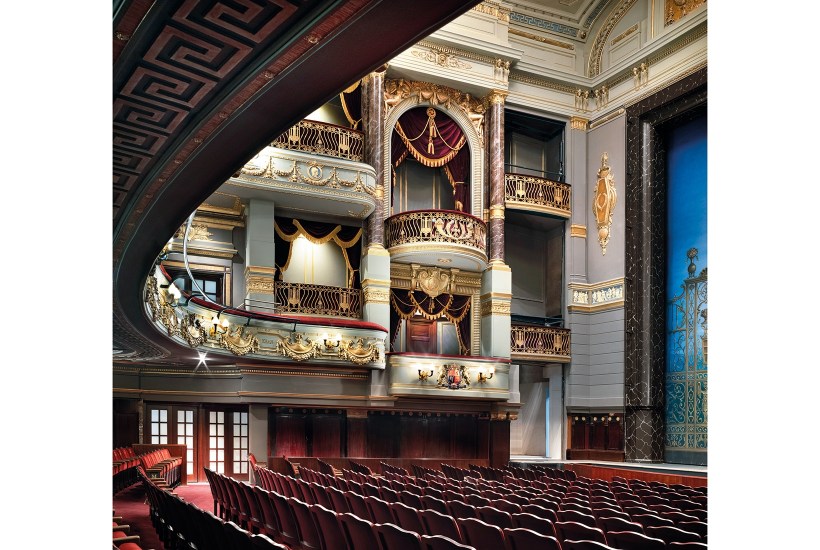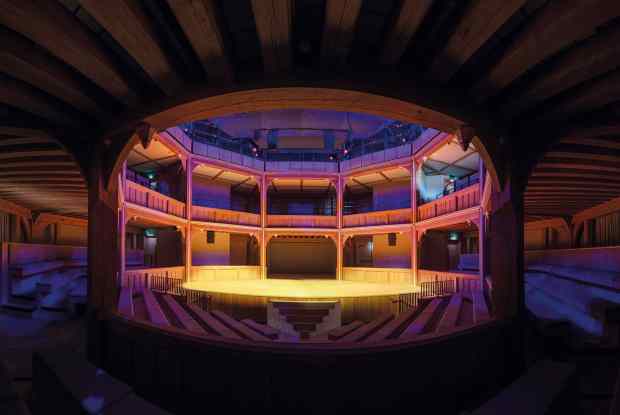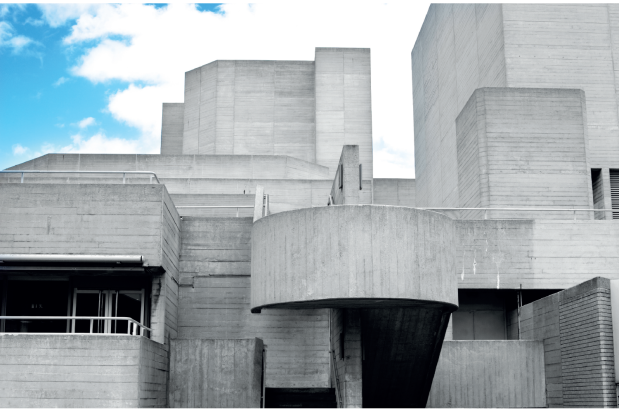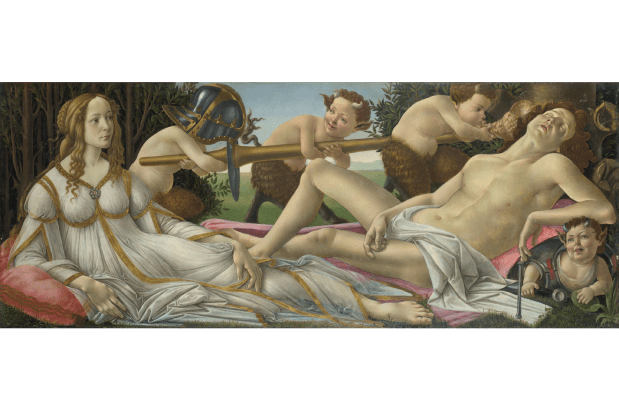Andrew Lloyd Webber has not been in the best of moods lately, largely thanks to all the Covid delays to his new musical Cinderella, now finally about to open — for the umpteenth announced time — at the Gillian Lynne Theatre. The bigger news, however, is that his theatre at the other end of Drury Lane, the grand old Theatre Royal, is finally finished after massive renovations.
Lloyd Webber has spent an awesome £60 million on the rebirth of his Grade I-listed theatre, known to show folk as ‘the Lane’, with his wife Madeleine heavily involved and in cahoots with the heritage expert Simon Thurley and the great theatre architect Steve Tompkins. The result? Oh my goodness! The sheer elegance of its 1812 Greek revival design by Benjamin Wyatt is drop-dead.
Few theatregoers ever really notice the building in the stampede for the bar and seats and 55 new ladies’ loos. Now you can walk in off the street at any time of day and wander around the building’s stately front-of-house rooms. (You’ll need a guided tour for the auditorium.) In effect, the Lloyd Webbers have made us all members of what looks like London’s grandest club. The theatre historically has been divided into two, the king’s side and the prince’s side. The story goes that after George III and his fat son and heir had a massive row on a visit, after which they remained on non-speakers, the venue was supplied with two royal boxes and separate staircases.
On the first floor is the rotunda and its Pantheon-inspired dome with square coffers, their size diminishing as they reach an oculus from which light floods on to a round walkway. Once you’ve completed a circular perambulation of loveliness, you can waft into the marble-pillared Grand Saloon — the plan is for tea to be served there — and on to the terrace above the original portico where Angela Conner’s superb bronze of Noël Coward — his 1931 show Cavalcade, which premièred here, had a cast of more than 400 — now sits with the inevitable cigarette in hand. On the south side of the theatre, in a brick alley, is a new all-day restaurant with greenery and Chekhovian birch trees.
In the foyer, Shakespeare, in clean alabaster tights, hovers just above the row of magnums in the champagne bar. He’s alongside statues of the demonic actor Edmund Kean — the Keith Moon of the Regency stage — and David Garrick, who ran the theatre from 1747 for 29 unparalleled years, ushering in a great revolution of unranty acting.
The history of musicals at the venue naturally appeals to the theatre’s owner. This is where the London premières of Oklahoma, Carousel, South Pacific and The King and I were all staged. On the walls of each cantilevered staircase the Lloyd Webbers have commissioned grisailles — painted putty-coloured panels in 3D effect — created by Ian Cairnie, depicting some of the theatre’s many legendary musical productions, including Show Boat (1928) and My Fair Lady (1958).
Once in the auditorium, the sheer lushness is eye-popping. Ten acres of paint and several kilos of gold leaf went into the makeover. There are four tiers of 2,000 seats in total. It’s vast yet almost cosy. The auditorium has also been reshaped to create a tighter curve, with flexibility built in to allow for a thrust stage and in-the-round performances.
The current playhouse is actually the fourth on the site. The first was constructed in 1663, under the management of Thomas Killigrew. Orange-seller Nell Gwyn made her acting debut there at the age of 15, and won the attention of Pepys (‘pretty, witty Nell’) and future lover Charles II. It burned down and a new building, by Christopher Wren, went up in 1674. It lasted for 117 years. It was here that Charles ‘wicked Charlie’ Macklin killed a fellow actor in a row over a wig (‘Goddamn you for a blackguard, scrub, rascal!’ he shouted, thrusting a cane into the actor’s eye and piercing his brain). Macklin got away with it and lived to be 106. His pupil and partner David Garrick kicked the audience off the stage and also invented the Shakespeare industry, staging two-thirds of the canon. In acknowledgment of this, the artist Maria Kreyn has been commissioned to paint several wildly dramatic canvases inspired by Shakespeare’s plays which now adorn the bases of either staircase.
The playwright Richard Sheridan took over the management from Garrick and ushered in actors such as Sarah Siddons (a famous Lady Macbeth whose sleepwalking was a wow) and her unsmiling brother John Philip Kemble, a great Coriolanus. Sheridan rebuilt the theatre in 1794 with the first safety curtain and water tanks and billed it ‘the Fireproof Theatre’. It burned down in 1809. He watched the flames, and his own financial ruin, with a bottle of port to hand. ‘A man may surely be allowed to take a glass of wine by his own fireside,’ he quipped. Wyatt was commissioned to build the theatre that exists today, although the auditorium dates back to only 1922. Gaslight — the first in a West End theatre if not an East End one — was added in 1817.
The theatre will soon relaunch with the Disney musical Frozen. Snobs may wince. But it’s in keeping with the venue’s gaudy tradition. Outside its front stands the terracotta fountain memorial to Augustus Harris (1852–96), nicknamed ‘Druriolanus’ by Punch. He made the Lane famous for spectacular shows and huge-budget pantomimes stuffed with music-hall celebs. The diminutive Dan Leno — at five foot he was one inch shorter than Ronnie Corbett — was a much-adored star, appearing in dame parts (Mother Goose was created for him) at every pantomime from 1888 to 1903. Like Harris, Leno (who drank) died aged 44.
Frozen’s sub-zero landscape will be nothing new: in its time the theatre has conjured up a mighty white avalanche, a full-on sandstorm (biscuit flour), underwater divers on a wreck, an air ship and a recreation of the 2,000 Guineas Stakes with real race horses and jockeys galloping on a travelator. The single helicopter in Miss Saigon (it ran for ten years, from 1989 to 1999, and is the theatre’s longest-running show) would have been a whole fleet of choppers had Harris been its producer.
Between the wars the theatre staged the musicals of Ivor Novello. There is a new painted roundel of him in the foyer flanked by cherubs with, inserted in faint shadow, the theatre’s famous tricorn-hatted ghost.
The critic Hannen Swaffer summed it up when he wrote about the venue ‘the history of which is the theatrical history of England’. Drury Lane has seen it all and staged it all. The place is the heart and soul of the West End and it has never looked better.
Got something to add? Join the discussion and comment below.
Get 10 issues for just $10
Subscribe to The Spectator Australia today for the next 10 magazine issues, plus full online access, for just $10.
Frozen the Musical is at the Theatre Royal Drury Lane from 27 August.
You might disagree with half of it, but you’ll enjoy reading all of it. Try your first month for free, then just $2 a week for the remainder of your first year.














Comments
Don't miss out
Join the conversation with other Spectator Australia readers. Subscribe to leave a comment.
SUBSCRIBEAlready a subscriber? Log in